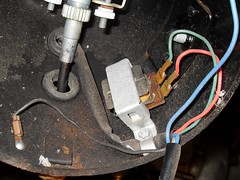The bike is usually started without the brake light. So the brake light doesn't matter then? I've lost track.
I have a simple mind.
Good!
Does any of the bulbs provide license plate illumination as an auxiliary function? i.e. Does the Tail light provide that function?
{Trying to determine if a lamp was replaced by a RED LED would the license plate be RED illuminated?)
What we know:
So the MC manufacturer basically adds the lamp (a.k.a. ballast resistor) at low RPM. If we assume that when the brakes are applied the RPM is typically idle.
A good size for the resistor would be a resistance that drops 6V (the same as the lamp) or 2.4 Ohms (15 W, 6V is known); Current is 2.5A
There is an ignition winding and a 6V Lamp winding.
It's good to have a resistance at low RPM. The main effect would be to lower the coil temperature and spark output at idle and make it less likely for the points to "stick".
The MC manufacturer MAY have chosen to make the 6 VAC coil slightly smaller by 2+ Amps or about (6*2.4) Watts.
You CANNOT replace the brake light directly with an LED replacement.
A "clipping regulator" will not help you for the brake light.
6 VAC LEDS probably don't exist.
From your "lighting set", there is no power to spare. 31.6 W magneto. A 30 W headlamp and some other misc bulbs. It could not handle 15 W of stop lamp, But the stop lamp is, sort of, an intermittent load and it's nearly half of the 6V capacity.
What you MIGHT be able to do:
Change some or all of the lamps to LEDs and be on the safe side, regain 15 or more Watts on the normal lamp circuit.
Changing to LEDs might mean rolling your own like the guys with the PCB did or modifyng and existing lamp. I could probably modify a #194 replacement that I have to be 6 VAC. It has 6 LED's and two 290 ohm resistors which presumably means two strings. I could add a resistor and a diode, but with the LEDs back to back, the diode should be unnecessary. I'm not claiming that an #1157 LED replacement can be done the same way, but it's something to think about.
I didn't look at the full manual of the bike to figure out what lights could be replaced with LEDs.
You could TRY a 2.5 ohm 20 Watt resistor permanently in series and see if the bike behaves correctly at high RPM. Alternatively, you could ride with the brake light on all the time for a stretch and see if there is any significant performance issues.
The idea is to switch a new LED lamp in place when the brake switch is opened rather than closed.
Is it easy to change the brake switch to something else like DPDT or SPDT? DPDT would make it cake.
If we had to, also switch independently the 2.5 ohm resistor. No idea how to do this, so it's just "thinking out loud" at this point with the following premise. Don't change the power draw significantly on the 6V side.
So, a 5A AC rated DPDT switch for the brake light and a 2.5 ohm 20 W resistor, you could be on your way. Only to be on the safe side, gain some extra power on the 6V side. Probably a LED , bulb for the tail/brake would do it.



